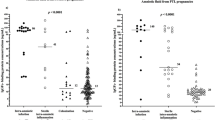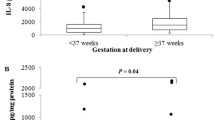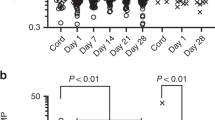Abstract
Objective:
To assess maternal serum activin A, an early phase response protein in systemic infection, as an early marker of intrauterine infection in women with preterm prelabour rupture of membranes (PPROM).
Study Design:
A prospective cohort study of women with singleton pregnancies complicated by PPROM at 24 to 34 weeks' gestation. Serum was collected for activin A and cytokine measurements. Activin A was measured using commercial enzyme-linked immunosorbent assay. Cytokines were measured using commercial multiplex assay. Pregnancy outcomes including infection were determined by case-record review.
Result:
Eighteen women with PPROM were studied, with seven developing intrauterine infection. Serum activin A in women with and without infection did not differ. Peripheral white cell count, interleukin (IL)-6 and IL-10 were higher (P=0.03, 0.05 and 0.009, respectively) and IL-7 lower (P=0.04) 72 h before delivery in women with infection.
Conclusion:
Activin A is not a clinically useful marker of intrauterine infection in women with PPROM.
This is a preview of subscription content, access via your institution
Access options
Subscribe to this journal
Receive 12 print issues and online access
$259.00 per year
only $21.58 per issue
Buy this article
- Purchase on Springer Link
- Instant access to full article PDF
Prices may be subject to local taxes which are calculated during checkout

Similar content being viewed by others
References
Goldenburg RL, Culhane JF, Iams JD, Romero R . Epidemiology and causes of preterm birth. Lancet 2008; 371: 75–84.
Gaudet L, Smith GN . Cerebral Palsy and chorioamnionitis: the inflammatory cytokine link. Obstet Gynecol Surv 2001; 56: 433–436.
Wu YW, Coleford JM . Chorioamnionitis as a risk factor for cerebral palsy: a meta-analysis. JAMA 2000; 284: 1417–1424.
Lieman JM, Brumfield CG, Carlo W, Ramsey PS . Preterm premature rupture of membranes: is there an optimal gestational age for delivery? Obstet Gynecol 2005; 105: 12–17.
Locatelli A, Ghidini A, Paterlini G, Patanè L, Doria V, Zorloni C et al. Gestational age at preterm premature rupture of membranes: a risk factor for neonatal white matter damage. Am J Obstet Gynecol 2005; 193: 947–951.
Buchanan S, Crowther C, Morris J . Preterm prelabour rupture of membranes: a survery of current practice. Aust NZ J Obstet Gynaecol 2004; 43: 400–403.
Royal College of Obstetricians and Gynaecologists. Preterm prelabour rupture of the membranes. RCOG Guideline No.44 2006 http://www.rcog.org.ukuk/index.asp?PageID=1813. Last accessed 19/12/08).
Carroll SG, Papaioannou S, Davies ET, Nicolaides KH . Maternal assessment in the prediction of intrauterine infection in preterm prelabor amniorrhexis. Fetal Diagn Ther 1995; 10: 290–296.
Yoon BH, Jun JK, Park KH . Serum C-reactive protein, white blood cell count, and amniotic fluid white blood cell count in women with preterm premature rupture of membranes. Obstet Gynecol 1996; 88: 1034–1040.
Trochez-Martinez RD, Smith P, Lamont RF . Use of C-reactive protein as a predictor of chorioamnionitis in preterm prelabour rupture of membranes: a systematic review. Br J Obstet Gynaecol 2007; 114: 796–801.
Denison FC, Elliott CL, Wallace EM . Dexamethasone-induced leucocytosis in pregnancy. Br J Obstet Gynaecol 1997; 104: 851–853.
Wallace EM, Ekkel K, Cotter T, Tippett C, Catalano J . Haematological effects of betamethasone treatment in late pregnancy. Aust NZ J Obstet Gynaecol 1998; 38: 396–398.
Del Valle GO, Joffe GM, Izquierdo LA, Smith JF, Gilson GJ, Curet LB . The biophysical profile and the nonstress test: poor predictors of chorioamnionitis and fetal infection in prolonged preterm premature rupture of membranes. Obstet Gynecol 1992; 80: 106–110.
Tong S, Wallace EM, Burger HG . Inhibins and activins: clinical advances in reproductive medicine. Clin Endocrinol 2003; 58: 115–127.
Wallace EM, Healy DL . Inhibins and activins: roles in clinical practice. Br J Obstet Gynaecol 1996; 103: 945–956.
Wallace EM, Riley SC, Crossley JA, Ritoe SC, Horne A, Shade M et al. Dimeric inhibins in amniotic fluid, maternal serum and fetal serum in human pregnancy. J Clin Endocrinol Metab 1997; 82: 218–222.
Riley SC, Balfour C, Wathen NC, Groome NP, Wallace EM . Inhibins in extra-embryonic coelomic and amniotic fluids and maternal serum in early pregnancy. Hum Reprod 1996; 11: 2722–2776.
Wallace EM, Schneider-Kolsky M, Thirunavukarasu P . Activin A, inhibin A, inhibin B and parturition: changes of maternal and cord serum levels according to the mode of delivery. Br J Obstet Gynaecol 2000; 107: 704–705.
Florio P, Severi FM, Bocchi C, Luisi S, Petraglia F . Abruptio placentae and highest maternal serum activin A levels at mid-gestation: a two cases report. Placenta 2003; 24: 279–280.
Muttukrishna S, Knight PG, Groome NP . Activin A and inhibin A as possible endocrine markers of pre-eclampsia. Lancet 1997; 349: 1285–1288.
D'Antona D, Reis FM, Benedetto C, Evans LW, Groome NP, de Kretser DM et al. Increased maternal serum activin A but not follistatin levels in pregnant women with hypertensive disorders. J Endocrinol 2000; 165: 157–162.
Manuelpillai U, Schneider-Kolsky M, Dole A, Wallace EM . Activin A and activin receptors in gestational tissue from preeclamptic pregnancies. J Endocrinol 2001; 171: 57–64.
Mandang S, Manuelpillai U, Wallace EM . Oxidative stress increases placental and endothelial cell activin A secretion. J Endocrinol 2007; 192: 485–493.
Barkehall-Thomas A, Tony S, Baker LS, Edwards A, Wallace EM . Maternal serum activin A and the prediction of intrauterine growth restriction. Aust NZ J Obstet Gynaecol 2006; 46: 97–101.
Wallace EM, Schneider-Kolsky ME, Edwards A, Baker L, Jenkin G . Maternal seum activin A levels in association with intrauterine fetal growth restriction. Br J Obstet Gynaecol 2003; 110: 306–310.
Petraglia F, Di Blasio AM, Florio P, Gallo R, Genazzani AR, Woodruff TK et al. High levels of fetal membrane activin beta A and activin receptor IIB mRNAs and augmented concentration of amniotic fluid activin A in women in term and preterm labor. J Endocrinol 1997; 154: 95–101.
Keelan JA, Zhou RL, Evans LW . Regulation of activin A, inhibin A, and follistatin production in human amnion and choriodecidual explants by inflammatory mediators. J Soc Gynecol Investig 2000; 7: 291–296.
Phillips DJ, Jones KL, Scheerlinck JY, Hedger MP, de Kretser DM . Evidence for activin A and follistatin involvement in the systemic inflammatory response. Mol Cell Endocrinol 2001; 180: 155–162.
Jones KL, de Kretser DM, Patella S, Phillips DJ . Activin A and follistatin in systemic inflammation. Mol Cell Endocrinol 2004; 225: 119–125.
Jones KL, Brauman JN, Groome NP, de Kretser DM, Phillips DJ . Activin A release into the circulation is an early event in systemic inflammation and precedes the release of follistatin. Endocrinology 2000; 141: 1905–1908.
Redline RW, Faye-Petersen O, Heller D, Qureshi F, Savell V, Vogler C . Society for Pediatric Pathology, Perinatal Section, Amniotic Fluid Infection Nosology Committee. Amniotic infection syndrome: nosology and reproducibility of placental reaction patterns. Pediatr Dev Pathol 2003; 6: 435–448.
Riley SC, Balfour C, Wathen NC, Chard T, Evans LW, Groome NP et al. Follistatin and activin-A in extra-embryonic coelomic and amniotic fluids and maternal serum in early pregnancy. Hum Reprod 1998; 13: 2624–2628.
Coleman MA, France JT, Schellenberg JC, Ananiev V, Townend K, Keelan JA et al. Corticotropin-releasing hormone, corticotropin-releasing hormone binding protein, and activin-A in maternal serum: prediction of preterm delivery and response to glucocorticoids in women with symptoms of pteterm labour. Am J Obstet Gynecol 2000; 183: 645–648.
Murtha AP, Sinclair T, Hauser ER, Swamy GK, Herbert WN, Heine RP . Maternal serum cytokines in preterm premature rupture of membranes. Obstet Gynecol 2007; 109: 121–127.
Acknowledgements
RH was the recipient of a Southern Health Emerging Researcher Fellowship and Research Project funding from the RANZCOG Research Foundation.
Author information
Authors and Affiliations
Corresponding author
Rights and permissions
About this article
Cite this article
Hodges, R., Salvador, L., D'Antona, D. et al. Activin A as a marker of intrauterine infection in women with preterm prelabour rupture of membranes. J Perinatol 30, 22–26 (2010). https://doi.org/10.1038/jp.2009.109
Received:
Revised:
Accepted:
Published:
Issue Date:
DOI: https://doi.org/10.1038/jp.2009.109



